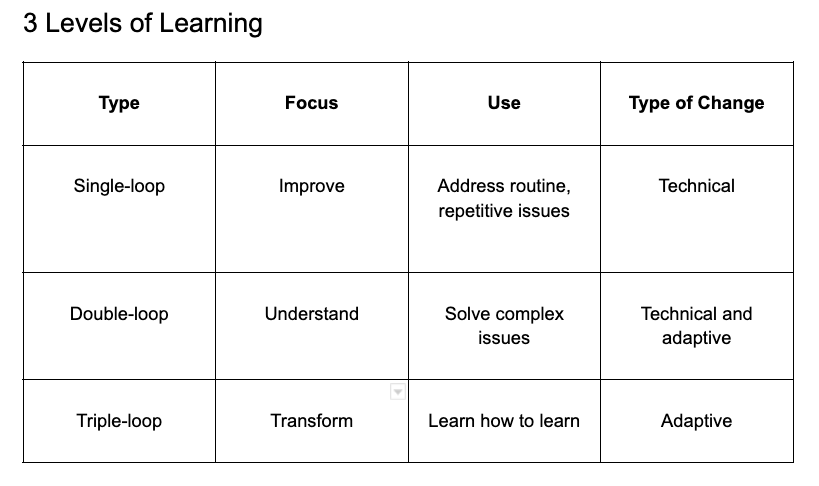What is Organizational Learning Theory?
Michael Keenan | WorkRamp Contributor
View bioLearning Tips Straight to Your Inbox
The goal of organizational learning is to improve companies through knowledge management and understanding. It involves the systems and networks to facilitate knowledge creation and transfer within an organization.
It’s easy to focus on individual learning but it’s becoming more vital than ever to put an emphasis on learning as an organization.
An industry survey states that, despite investing in digital transformation for two years to survive the pandemic, 75 percent of companies fear lagging innovation will lead to competitive displacement.
Companies like Apple and Microsoft have been around for decades. As they’ve navigated the ups and downs, they’ve continued to provide their customers with the best products and stay competitive.
How have they stayed relevant?
The secret to success is organizational learning, one of the most fundamental sources of competitive advantage and business performance today.
Discover more about organizational learning and why it’s important to maintain your competitive advantage and improve performance.
In this post:
What is organizational learning?
As the name implies, organizational learning is when an entire organization levels up by acquiring the skills, knowledge, and experience it needs to evolve and improve.
Organizational learning is crucial for employee development and retention and helps the entire company improve.
Read more: 6 Effective Ways to Support Employee Career Growth
4 Principles of organizational learning
There are four principles of organizational learning:
- Access to information is easy. Employees have access to all valuable information. With a learning management system (LMS), they can set up a learning hub where employees can take courses, earn certifications, and access resources.
- Learning is important. Organizations apply learning well and emphasize a learning culture to stay successful. They prioritize employee training and give everyone a chance to develop their skills.
- It’s OK to make mistakes. Making mistakes and fixing them is better than avoiding them altogether, according to research. Learning organizations allow people to make mistakes and help them learn from them.
- It’s expected that people learn. Organizations that value learning and development (L&D) encourage people to train. As a result, companies become more productive because employees learn new ways to solve problems.
Learners will adapt better, recover quicker, and steer the company in the right direction if organizations help them focus on skills and strategies that enhance their performance.
[Learning] organizations where people continually expand their capacity to create the results they truly desire, where new and expansive patterns of thinking are nurtured, where collective aspiration is set free, and where people are continually learning to see the whole together.
-Peter Senge, author of The Fifth Discipline: The Art & Practice of The Learning Organization
Organizational learning theory: types of learning
Organizational learning theory was developed by Chris Agris and Donald Schon in the 70s. It’s based on the idea that people learn from their mistakes. “The process of detecting and fixing mistakes” is what Agris defines as organizational learning.
These two researchers popularized single- and double-loop learning. As part of his work, Peter Senge and other scientists further conceptualized learning into three levels: single-loop, double-loop, and triple-loop.

Single-loop learning
Using single-loop learning, you can evaluate success and failure to get different outcomes in the future. The focus is only on actions, not assumptions or behavior patterns. Rather than asking “why,” it tries to figure out “how.”
Using single-loop learning, employees learn new skills and capabilities incrementally without questioning the rules. They tackle routine and repetitive issues that don’t challenge any mental models or assumptions. When you make a mistake, you’re deviating from the ideal.
Let’s say your marketing team delivers a campaign late. Using single-loop learning, they decide the next campaign needs more time to deliver on schedule.
Double-loop learning
The double-loop learning approach changes people’s beliefs, ideas, and attitudes. Organizations can adapt to external changes continuously and excel with this approach.
Double-loop learning focuses on “why” questions to improve understanding and develop new skills. It tries to figure out why a particular approach works.
Mistakes are acknowledged, but employees are encouraged to challenge their assumptions and figure out what caused them. This method is more reflective and helps you solve complex, non-programmable problems.
If your marketing team turned in a campaign late, you’d look at the root cause. Did the approval process take too long? Is more help needed? Did our software work the whole time? Compared to single-loop, double-loop learning helps create organizational change.
Triple-loop learning
Triple-loop learning includes single- and double-loop learning. It teaches organizations how to learn. As a result, you think about learning differently and challenge mental models and assumptions. It also connects different departments through strategic learning experiences.
Employees know how to tap into every department’s collective knowledge with triple-loop learning. They learn what motivates them to learn, and what sets them back, and can come up with new strategies.
Where organizational learning happens
The organizational learning process happens among different communities in a workplace:
- Individual learning. Occurs through a single person. An employee can take a training program to learn new skills.
- Group. Where learning and knowledge transfer happen through social experiences. You can do this through mentoring or peer groups. Group members share feedback and personal knowledge and apply it to the organization.
- Organization. Learning is a core value of the company. Executives will implement programs to help employees adapt to external pressures and improve efficiency.
- Interorganizational. Two or more organizations come together to learn from each other. For example, an organization might partner with a learning platform to learn how to implement learning programs. It also helps the LMS provider improve service offerings for future clients by learning about their internal processes.
Why is organizational learning important?
The main reason for organizational learning is to adapt to an ever-changing business environment. Organizations want to meet customer needs, but trends and changing technologies influence its ability to keep up.
Ellyn Lyle, PhD, researcher and Dean in the Faculty of Education at Yorkville University, identified three changing areas that stimulate the need to improve organizational knowledge and learning: social and economic climate, work environment, and customer expectations.
Based on Lyle’s findings, there are three main reasons organizational learning is important:
- Maintain competitive advantage. Globalization and increasing competition is demanding more innovation from organizations. New skills and knowledge are constantly required in order to stay ahead.
- Increase internal knowledge sharing. Teams that learn together are more productive than those that learn in silos. Employees also want to invest more in their careers. A company with a culture of learning results in happier, smarter, and more productive employees—which is critical to long-term survival.
- Meet customer demand. Customers have endless choices today when it comes to partnerships. When an organization creates and transfers knowledge, it makes it easier for teams to solve customer problems with fewer resources, which aids in retention.
“Who are the companies that will thrive amidst all this uncertainty? It’s simple, it’s the companies who can learn faster than everyone else.”
–Ted Blosser, CEO & Co-Founder, WorkRamp
Read more: LEARN Recap: Learning is the Ultimate Competitive Advantage
Organizational learning theory in practice
Learning refers to acquiring new knowledge and using it to improve performance. It happens both on an individual, group, and organizational level throughout any successful company.
By implementing organizational learning theory into your company, you will perform better, be more competitive, and be more agile.
How WorkRamp can support organizational learning
According to Citrix, 88 percent of employees prefer firms that use technology to enable learning. With WorkRamp, you can streamline your learning and development programs, develop employees faster, and maintain a competitive advantage.
WorkRamp helps you implement self-paced and virtual-led training for employees. You can schedule training sessions and deliver them all online.
WorkRamp also supports organization learning in the following ways:
- Provide learners with targeted, flexible corporate training programs
- Offer instructor-led, face-to-face training with personalized feedback
- Provide opportunities to exchange knowledge and materials
- Make eLearning more fun with interactive interfaces, badges, leaderboards, and contests
- Monitor employee performance and provide assistance as needed
Want to stay ahead of your competition? Learn how WorkRamp can help you promote organizational learning. Contact us to schedule a free, personalized demo.
Complete the form for a custom demo.
Recent Posts
- WorkRamp Launches AI Practice to Revolutionize Sales Enablement July 22, 2024
- How to Recognize Employee Burnout July 17, 2024
- What is the Best SCORM-compliant LMS? July 10, 2024
- How to Make a Training Module For Online Learning (2024 Guide) July 1, 2024
- The Role of Emotional Intelligence in Sales Enablement June 28, 2024
Michael Keenan
WorkRamp ContributorMichael is a SaaS marketer living in Guadalajara, Mexico. Through storytelling and data-driven content, his focus is providing valuable insight and advice on issues that prospects and customers care most about. He’s inspired by learning people’s stories, climbing mountains, and traveling with his partner and Xoloitzcuintles.
You might also like
What are the benefits of online learning?
When it comes to professional development and continued learning, online courses and programs offer several advantages over traditional in-person options.
Read More
What is multimodal learning?
Creating a learning environment that considers your team's different needs isn’t easy. Here’s how to identify individual employee learning styles and create a development plan that engages your team.
Read More
Discover how increasing your L&D budget benefits your team and your organization
Your team is your greatest asset, and investing in their learning and development benefits your business.
Read More
Decrease Ramp Time and Increase Revenue
Get in touch to learn how WorkRamp can help you achieve your learning and development goals.
Request a Demo




